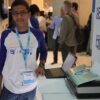Wednesday, June 8th, 2016 by
Marian Bechtel, a 21-year-old student at Bryn Mawr College, is a pianist, scientist and anti-war activist. The young woman from Lancaster, Pennsylvania invented an inexpensive, quick and simple minesweeper that detects buried landmines using sound waves. The device is a standard metal detector with high-sensitivity microphones and a seismic detector attached to it. Marian’s device could prove essential in advancing humanitarian demining around the world.
minesweeper that detects buried landmines using sound waves. The device is a standard metal detector with high-sensitivity microphones and a seismic detector attached to it. Marian’s device could prove essential in advancing humanitarian demining around the world.
According to the Landmine and Cluster Munition Monitor, in 2013, around 59 states and four other areas were confirmed to be affected by anti-personal landmines. Buried landmines continue to kill thousands of innocent civilians and to negatively impact communities across the world. In 2012, a global total of 3,628 landmine-related casualties were recorded, many more remaining undocumented. Buried landmines often deprive communities of their productive land needed for farming and cut off access to economically vital areas, such as roads, electricity pylons and dams. They also burden national health-care systems, given that medical treatment for landmine victims is costly.
The devices most commonly used at the moment, metal detectors and probing spikes, have a 95 percent false alarm rate, as they cannot discriminate between landmines and clutter, meaning that most of the global funds provided for landmine detection end up being spent on trash collection.
Marian started realizing the ongoing gravity of the global landmine problem and felt compelled to take action. She came up with her idea in the eighth grade, when she first became aware of the problems created by landmines. At that time, Marian’s parents, who are also scientists, hosted a group of international scientists, who were working to develop a holographic radar device for detecting buried landmines. The key weakness with their device was it was useless in wet environments.
Listen to Marian’s brilliant TedTalk
Marian was inspired by their work and starting thinking of other solutions for landmine detection. One day, she was playing the piano, when she suddenly noticed that the strings on a banjo hanging on a wall nearly resonated when she played certain chords or notes. Marian started thinking that acoustic or seismic waves could excite a buried landmine, permitting its detection even in wet soils.
Marian successfully tested her idea, using a concrete vibrator, usually employed in extracting bubbles out drying concrete, to send seismic waves through the ground and making any buried landmines resonated. The young inventor used real mine casings without the explosives and created mock landmines out of candy tins filled with RTV silicone rubber. She also determined the seismo-acoustics works well in wet environments. After three years of hard work and research, she came up with a prototype.
Recognition for her work quickly followed. In her final year of high-school, Marian was selected as a finalist for the Intel Talent Search competition. She also took part in the White House Science Fair as well as the United Kingdom’s Royal Society’s 250 Summer Science Exhibition in London. The young inventor has published her work in Mine Action and the Journal of ERW and Mine Action.
In terms of future plans, Marian has stated that she certainly wants to remain involved in science, perhaps do particle physics and work at CERN in Switzerland, the European Organization for Nuclear Research, one of the world’s largest and most respected centers for scientific research.
Subscribe
Sorry, there are no posts.





 minesweeper that detects buried landmines using sound waves. The device is a
minesweeper that detects buried landmines using sound waves. The device is a